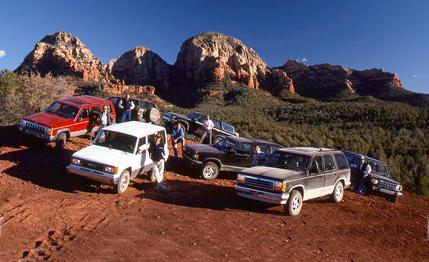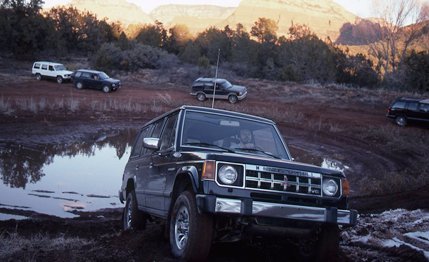 Archived Comparison
Archived Comparison
Sport-utility vehicles are nothing like Brussels sprouts, except in one respect: either you just naturally love the little beasties or you can't quite grasp what other people see in them. Both of these views, as matters of personal taste, are entirely valid. And each, it turns out, is well represented within the ranks of the Car and Driver editorial staff. That's a good thing, because it meant that a three-day, seven-vehicle expedition in the deserts and mountains of central Arizona would lead to spirited discussion, conscientious judgment, and clear-cut conclusions about today's highly competitive crop of mid-size, four-door, all-wheel-drive sport-utility machines.
Fans of these truck/station-wagon hybrids applaud the vehicles for their ruggedness, their go-anywhere capability, and especially their wide-ranging versatility. You can load these machines with anything from mothers-in-law to mining gear and head off for the corner store or the Continental Divide. Three-quarters of a million new sport-utility vehicles (SUVs) found homes in 1988, and the buyers were a diverse lot that included hard-core truck guys and family types looking for a safe and roomy sedan alternative. The category shows every indication of continued growth too, with more buyers, more models, and more marques (even Oldsmobile, for heaven's sake) flooding into the marketplace.
At the same time, skeptics are absolutely right when they observe that almost all SUV drivers spend most of their time on perfectly good paved roads. Many modern four-wheel-drive trucks never see a mud bog or a rocky stream bed in their lives. And if it's just snow you're worried about, well, there are four-wheel-drive passenger cars at almost every price level. So in a real sense, these do-anything SUVs have compromised their on-road ride and handling in favor of a task they perform only rarely. Maybe never. Is that a sound approach to engineering personal transportation? Is it a reasonable concession to make in purchasing a family car?

Those inclined to like SUVs will say, sure, it can be a good trade-off—if the engineering is carried out skillfully enough. Those unenlightened to SUVs’ innate appeal will say, I dunno, these things still have to function as automobiles.
And that gives us the makings of a revealing comparison test. How do SUVs function? How well have they been engineered? How effectively have various manufacturers handled the compromises? In short, how do the players in this league really stack up, by hard-nosed road testers' standards?
We put seven editors in seven SUVs and sent them out over 350 miles of freeway, back road, dirt track, and creek bed to get the answers.
Our field comprised the seven SUVs that fit between the lightweight Sidekick-class funmobiles and the prestigious Range Rover-class heavy hitters. We specified four doors, six-cylinder engines, and automatic transmissions across the board. In alphabetical order, here's the group: the Ford Explorer Eddie Bauer, the GMC S-15 Jimmy SLX, the Isuzu Trooper LS, the Jeep Cherokee Laredo, the Mitsubishi Montero LS, the Nissan Pathfinder SE, and the Toyota 4Runner SRS. And here they are again, in the order that emerged after our editors had their way with them and scored them on their overall goodness.